เคล็ดลับของ Excel: แบ่งข้อมูลออกเป็นแผ่นงาน / สมุดงานหลายแผ่นตามค่าคอลัมน์
เมื่อจัดการชุดข้อมูลขนาดใหญ่ใน Excel จะมีประโยชน์อย่างมากในการแบ่งข้อมูลออกเป็นหลายแผ่นงานตามค่าคอลัมน์ที่ระบุ วิธีการนี้ไม่เพียงปรับปรุงการจัดระเบียบข้อมูล แต่ยังเพิ่มความสามารถในการอ่านและอำนวยความสะดวกในการวิเคราะห์ข้อมูลได้ง่ายขึ้น
สมมติว่าคุณมีบันทึกการขายจำนวนมากที่มีหลายรายการ เช่น ชื่อผลิตภัณฑ์ ปริมาณที่ขายในไตรมาสแรก เป้าหมายคือการแบ่งข้อมูลนี้ออกเป็นแผ่นงานแยกกันตามชื่อผลิตภัณฑ์แต่ละชื่อ เพื่อให้สามารถวิเคราะห์ประสิทธิภาพการขายแต่ละรายการแยกกันได้
แบ่งข้อมูลออกเป็นหลายแผ่นงานตามค่าคอลัมน์
แบ่งข้อมูลออกเป็นหลายสมุดงานตามค่าคอลัมน์ด้วยรหัส VBA
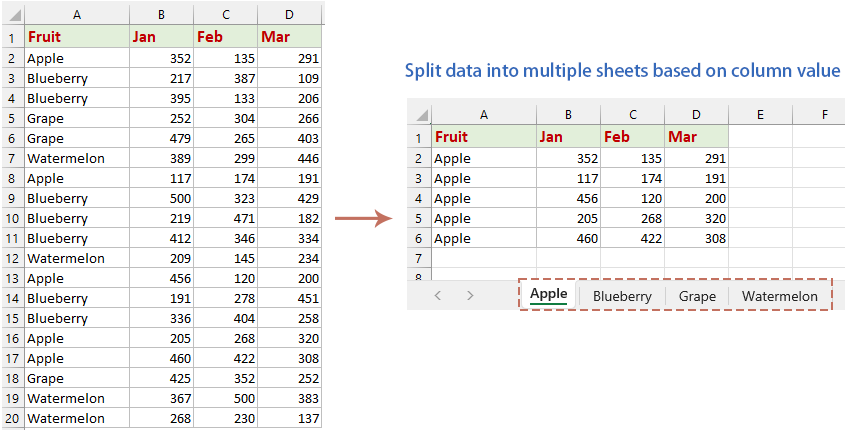
แบ่งข้อมูลออกเป็นหลายแผ่นงานตามค่าคอลัมน์
โดยปกติ คุณสามารถเรียงลำดับรายการข้อมูลก่อน จากนั้นจึงคัดลอกและวางทีละรายการลงในเวิร์กชีตใหม่อื่นๆ แต่คุณจะต้องใช้ความอดทนในการคัดลอกและวางซ้ำๆ ในส่วนนี้ เราจะแนะนำสองวิธีที่ตรงไปตรงมาเพื่อจัดการงานนี้ใน Excel ได้อย่างมีประสิทธิภาพ ช่วยคุณประหยัดเวลาและลดโอกาสที่จะเกิดข้อผิดพลาด
แบ่งข้อมูลออกเป็นหลายแผ่นงานตามค่าคอลัมน์ด้วยรหัส VBA
1. กดปุ่ม ALT + F11 คีย์เพื่อเปิด Microsoft Visual Basic สำหรับแอปพลิเคชัน หน้าต่าง
2 คลิก สิ่งที่ใส่เข้าไป > โมดูลและวางรหัสต่อไปนี้ในหน้าต่างโมดูล
Sub Splitdatabycol()
'updateby Extendoffice
Dim lr As Long
Dim ws As Worksheet
Dim vcol, i As Integer
Dim icol As Long
Dim myarr As Variant
Dim title As String
Dim titlerow As Integer
Dim xTRg As Range
Dim xVRg As Range
Dim xWSTRg As Worksheet
Dim xWS As Worksheet
On Error Resume Next
Set xTRg = Application.InputBox("Please select the header rows:", "Kutools for Excel", "", Type:=8)
If TypeName(xTRg) = "Nothing" Then Exit Sub
Set xVRg = Application.InputBox("Please select the column you want to split data based on:", "Kutools for Excel", "", Type:=8)
If TypeName(xVRg) = "Nothing" Then Exit Sub
vcol = xVRg.Column
Set ws = xTRg.Worksheet
lr = ws.Cells(ws.Rows.Count, vcol).End(xlUp).Row
title = xTRg.AddressLocal
titlerow = xTRg.Cells(1).Row
icol = ws.Columns.Count
ws.Cells(1, icol) = "Unique"
Application.DisplayAlerts = False
If Not Evaluate("=ISREF('xTRgWs_Sheet!A1')") Then
Sheets.Add(after:=Worksheets(Worksheets.Count)).Name = "xTRgWs_Sheet"
Else
Sheets("xTRgWs_Sheet").Delete
Sheets.Add(after:=Worksheets(Worksheets.Count)).Name = "xTRgWs_Sheet"
End If
Set xWSTRg = Sheets("xTRgWs_Sheet")
xTRg.Copy
xWSTRg.Paste Destination:=xWSTRg.Range("A1")
ws.Activate
For i = (titlerow + xTRg.Rows.Count) To lr
On Error Resume Next
If ws.Cells(i, vcol) <> "" And Application.WorksheetFunction.Match(ws.Cells(i, vcol), ws.Columns(icol), 0) = 0 Then
ws.Cells(ws.Rows.Count, icol).End(xlUp).Offset(1) = ws.Cells(i, vcol)
End If
Next
myarr = Application.WorksheetFunction.Transpose(ws.Columns(icol).SpecialCells(xlCellTypeConstants))
ws.Columns(icol).Clear
For i = 2 To UBound(myarr)
ws.Range(title).AutoFilter field:=vcol, Criteria1:=myarr(i) & ""
If Not Evaluate("=ISREF('" & myarr(i) & "'!A1)") Then
Set xWS = Sheets.Add(after:=Worksheets(Worksheets.Count))
xWS.Name = myarr(i) & ""
Else
xWS.Move after:=Worksheets(Worksheets.Count)
End If
xWSTRg.Range(title).Copy
xWS.Paste Destination:=xWS.Range("A1")
ws.Range("A" & (titlerow + xTRg.Rows.Count) & ":A" & lr).EntireRow.Copy xWS.Range("A" & (titlerow + xTRg.Rows.Count))
Sheets(myarr(i) & "").Columns.AutoFit
Next
xWSTRg.Delete
ws.AutoFilterMode = False
ws.Activate
Application.DisplayAlerts = True
End Sub3. จากนั้นกด F5 เพื่อเรียกใช้โค้ด และกล่องพร้อมท์จะปรากฏขึ้นเพื่อเตือนให้คุณเลือกแถวส่วนหัว จากนั้นจึงคลิก OK. ดูภาพหน้าจอ: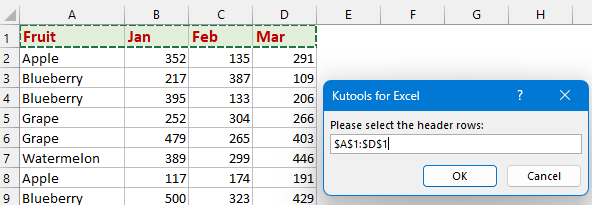
4. ในกล่องข้อความที่สอง โปรดเลือกข้อมูลคอลัมน์ที่คุณต้องการแบ่งตาม จากนั้นคลิก OK. ดูภาพหน้าจอ: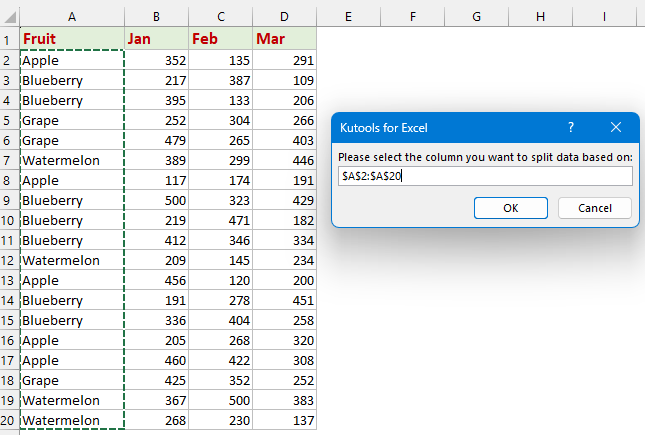
5. ข้อมูลทั้งหมดในแผ่นงานที่ใช้งานอยู่จะถูกแบ่งออกเป็นแผ่นงานหลายแผ่นตามค่าของคอลัมน์ แผ่นงานผลลัพธ์จะถูกตั้งชื่อตามค่าในเซลล์แยกและวางไว้ที่ส่วนท้ายของสมุดงาน ดูภาพหน้าจอ:
แบ่งข้อมูลออกเป็นแผ่นงานหลายแผ่นตามค่าคอลัมน์ด้วย Kutools for Excel
Kutools สำหรับ Excel นำเสนอคุณสมบัติอันชาญฉลาด - แยกข้อมูล เข้าสู่สภาพแวดล้อม Excel ของคุณ การแบ่งข้อมูลออกเป็นหลายแผ่นงานไม่ใช่เรื่องท้าทายอีกต่อไป เครื่องมือที่ใช้งานง่ายของเราจะแบ่งชุดข้อมูลของคุณโดยอัตโนมัติตามค่าคอลัมน์หรือจำนวนแถวที่เลือก เพื่อให้มั่นใจว่าข้อมูลแต่ละชิ้นอยู่ในตำแหน่งที่คุณต้องการ บอกลางานที่น่าเบื่อในการจัดระเบียบสเปรดชีตด้วยตนเอง และหันมาใช้วิธีจัดการข้อมูลที่รวดเร็วยิ่งขึ้นและปราศจากข้อผิดพลาด
หลังจากการติดตั้ง Kutools สำหรับ Excelเลือกช่วงข้อมูล จากนั้นคลิก Kutools พลัส > แยกข้อมูล เพื่อเปิด แยกข้อมูลออกเป็นหลายแผ่นงาน กล่องโต้ตอบ
- เลือก คอลัมน์เฉพาะ ตัวเลือกใน แยกตาม และเลือกค่าคอลัมน์ที่คุณต้องการแบ่งข้อมูลตามจากรายการแบบเลื่อนลง
- หากข้อมูลของคุณมีส่วนหัวและคุณต้องการแทรกลงในแผ่นงานแยกใหม่แต่ละแผ่น โปรดตรวจสอบ ข้อมูลของฉันมีส่วนหัว ตัวเลือก. (คุณสามารถระบุจำนวนแถวส่วนหัวตามข้อมูลของคุณ ตัวอย่างเช่น หากข้อมูลของคุณมีสองส่วนหัว โปรดพิมพ์ 2)
- จากนั้นคุณสามารถระบุชื่อแผ่นงานแยกภายใต้ ชื่อแผ่นงานใหม่ ส่วนระบุกฎชื่อแผ่นงานจากรายการแบบเลื่อนลงกฎคุณสามารถเพิ่มได้ อุปสรรค or วิภัตติ สำหรับชื่อแผ่นงานด้วย
- คลิก OK ปุ่ม. ดูภาพหน้าจอ:

ขณะนี้ ข้อมูลในแผ่นงานถูกแบ่งออกเป็นแผ่นงานหลายแผ่นในสมุดงานใหม่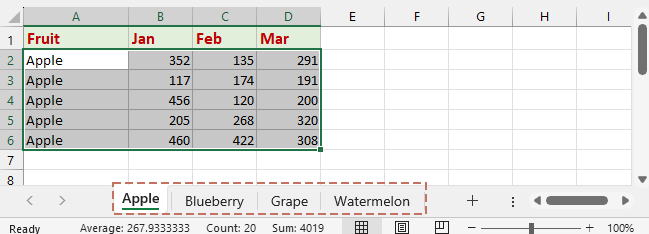
แบ่งข้อมูลออกเป็นหลายสมุดงานตามค่าคอลัมน์ด้วยรหัส VBA
ในบางครั้ง แทนที่จะแบ่งข้อมูลออกเป็นหลายเวิร์กชีต การแบ่งข้อมูลออกเป็นเวิร์กบุ๊กแยกกันตามคอลัมน์หลักอาจเป็นประโยชน์มากกว่า ต่อไปนี้เป็นคำแนะนำทีละขั้นตอนเกี่ยวกับวิธีใช้โค้ด VBA เพื่อทำให้กระบวนการแบ่งข้อมูลออกเป็นหลายสมุดงานโดยอัตโนมัติตามค่าคอลัมน์ที่ระบุ
1. กดปุ่ม ALT + F11 คีย์เพื่อเปิด Microsoft Visual Basic สำหรับแอปพลิเคชัน หน้าต่าง
2 คลิก สิ่งที่ใส่เข้าไป > โมดูลและวางรหัสต่อไปนี้ในไฟล์ หน้าต่างโมดูล.
Sub SplitDataByColToWorkbooks()
' Updateby Extendoffice
Dim lr As Long
Dim ws As Worksheet
Dim vcol, i As Integer
Dim myarr As Variant
Dim title As String
Dim titlerow As Integer
Dim xTRg As Range
Dim xVRg As Range
Dim xWS As Workbook
Dim savePath As String
' Set the directory to save new workbooks
savePath = "C:\Users\AddinsVM001\Desktop\multiple files\" ' Modify this path as needed
Application.DisplayAlerts = False
Set xTRg = Application.InputBox("Please select the header rows:", "Kutools for Excel", Type:=8)
If TypeName(xTRg) = "Nothing" Then Exit Sub
Set xVRg = Application.InputBox("Please select the column you want to split data based on:", "Kutools for Excel", Type:=8)
If TypeName(xVRg) = "Nothing" Then Exit Sub
vcol = xVRg.Column
Set ws = xTRg.Worksheet
lr = ws.Cells(ws.Rows.Count, vcol).End(xlUp).Row
title = xTRg.Address(False, False)
titlerow = xTRg.Row
ws.Columns(vcol).AdvancedFilter Action:=xlFilterCopy, CopyToRange:=ws.Cells(1, ws.Columns.Count), Unique:=True
myarr = Application.Transpose(ws.Cells(1, ws.Columns.Count).Resize(ws.Cells(ws.Rows.Count, ws.Columns.Count).End(xlUp).Row).Value)
ws.Cells(1, ws.Columns.Count).Resize(ws.Cells(ws.Rows.Count, ws.Columns.Count).End(xlUp).Row).ClearContents
For i = 2 To UBound(myarr)
Set xWS = Workbooks.Add
ws.Range(title).AutoFilter Field:=vcol, Criteria1:=myarr(i)
ws.Range("A" & titlerow & ":A" & lr).SpecialCells(xlCellTypeVisible).EntireRow.Copy
xWS.Sheets(1).Cells(1, 1).PasteSpecial Paste:=xlPasteAll
xWS.SaveAs Filename:=savePath & myarr(i) & ".xlsx"
xWS.Close SaveChanges:=False
Next i
ws.AutoFilterMode = False
Application.DisplayAlerts = True
ws.Activate
End Sub
3. จากนั้นกด F5 เพื่อเรียกใช้โค้ด และกล่องพร้อมท์จะปรากฏขึ้นเพื่อเตือนให้คุณเลือกแถวส่วนหัว จากนั้นจึงคลิก OK. ดูภาพหน้าจอ:
4. ในกล่องข้อความที่สอง โปรดเลือกข้อมูลคอลัมน์ที่คุณต้องการแบ่งตาม จากนั้นคลิก OK. ดูภาพหน้าจอ:
5. หลังจากแยกข้อมูลทั้งหมดในแผ่นงานที่ใช้งานอยู่จะถูกแบ่งออกเป็นสมุดงานหลายเล่มตามค่าของคอลัมน์ สมุดงานแยกทั้งหมดจะถูกบันทึกลงในโฟลเดอร์ที่คุณระบุ ดูภาพหน้าจอ: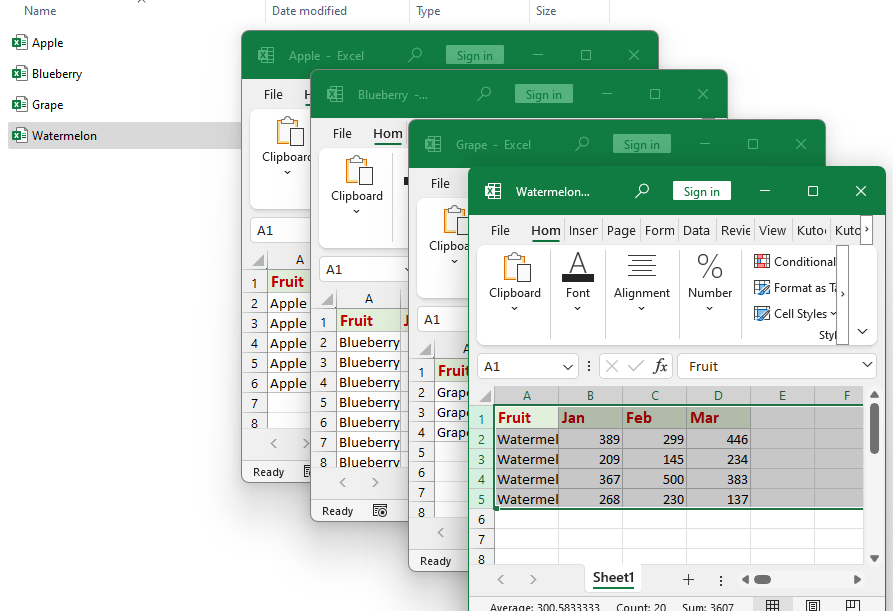
บทความที่เกี่ยวข้อง:
- แยกข้อมูลออกเป็นหลายแผ่นตามจำนวนแถว
- การแบ่งช่วงข้อมูลขนาดใหญ่ออกเป็นแผ่นงาน Excel หลายแผ่นอย่างมีประสิทธิภาพตามจำนวนแถวที่เฉพาะเจาะจงสามารถปรับปรุงการจัดการข้อมูลได้อย่างมีประสิทธิภาพ ตัวอย่างเช่น การแบ่งชุดข้อมูลทุกๆ 5 แถวออกเป็นหลายๆ ชีตจะทำให้สามารถจัดการและจัดระเบียบได้มากขึ้น คู่มือนี้เสนอวิธีการปฏิบัติสองวิธีเพื่อให้งานนี้สำเร็จอย่างรวดเร็วและง่ายดาย
- รวมสองตารางขึ้นไปเป็นตารางเดียวโดยยึดตามคอลัมน์หลัก
- สมมติว่าคุณมีสามตารางในสมุดงานตอนนี้คุณต้องการรวมตารางเหล่านี้เป็นตารางเดียวโดยยึดตามคอลัมน์หลักที่เกี่ยวข้องเพื่อให้ได้ผลลัพธ์ตามภาพด้านล่างที่แสดง นี่อาจเป็นงานที่ยุ่งยากสำหรับพวกเราส่วนใหญ่ แต่โปรดอย่ากังวลบทความนี้ฉันจะแนะนำวิธีการบางอย่างในการแก้ปัญหานี้
- แยกสตริงข้อความตามตัวคั่นออกเป็นหลายแถว
- โดยปกติ คุณสามารถใช้คุณลักษณะข้อความเป็นคอลัมน์เพื่อแบ่งเนื้อหาของเซลล์ออกเป็นหลายคอลัมน์โดยใช้ตัวคั่นเฉพาะ เช่น เครื่องหมายจุลภาค จุด เครื่องหมายอัฒภาค ทับ ฯลฯ แต่บางครั้ง คุณอาจต้องแบ่งเนื้อหาของเซลล์ที่คั่นออกเป็นหลายแถว และทำซ้ำข้อมูลจากคอลัมน์อื่นตามภาพด้านล่างที่แสดง คุณมีวิธีที่ดีในการจัดการกับงานนี้ใน Excel หรือไม่? บทช่วยสอนนี้จะแนะนำวิธีการที่มีประสิทธิภาพในการทำงานนี้ให้สำเร็จใน Excel
- แยกเนื้อหาเซลล์หลายบรรทัดออกเป็นแถว/คอลัมน์ที่แยกจากกัน
- สมมติว่าคุณมีเนื้อหาเซลล์หลายบรรทัดที่คั่นด้วย Alt + Enter และตอนนี้คุณต้องแยกเนื้อหาหลายบรรทัดออกเป็นแถวหรือคอลัมน์ที่แยกจากกัน คุณจะทำอย่างไร ในบทความนี้ คุณจะได้เรียนรู้วิธีแยกเนื้อหาของเซลล์หลายบรรทัดออกเป็นแถวหรือคอลัมน์ที่แยกจากกันอย่างรวดเร็ว
สุดยอดเครื่องมือเพิ่มผลผลิตในสำนักงาน
เพิ่มพูนทักษะ Excel ของคุณด้วย Kutools สำหรับ Excel และสัมผัสประสิทธิภาพอย่างที่ไม่เคยมีมาก่อน Kutools สำหรับ Excel เสนอคุณสมบัติขั้นสูงมากกว่า 300 รายการเพื่อเพิ่มประสิทธิภาพและประหยัดเวลา คลิกที่นี่เพื่อรับคุณสมบัติที่คุณต้องการมากที่สุด...

แท็บ Office นำอินเทอร์เฟซแบบแท็บมาที่ Office และทำให้งานของคุณง่ายขึ้นมาก
- เปิดใช้งานการแก้ไขและอ่านแบบแท็บใน Word, Excel, PowerPoint, ผู้จัดพิมพ์, Access, Visio และโครงการ
- เปิดและสร้างเอกสารหลายรายการในแท็บใหม่ของหน้าต่างเดียวกันแทนที่จะเป็นในหน้าต่างใหม่
- เพิ่มประสิทธิภาพการทำงานของคุณ 50% และลดการคลิกเมาส์หลายร้อยครั้งให้คุณทุกวัน!
